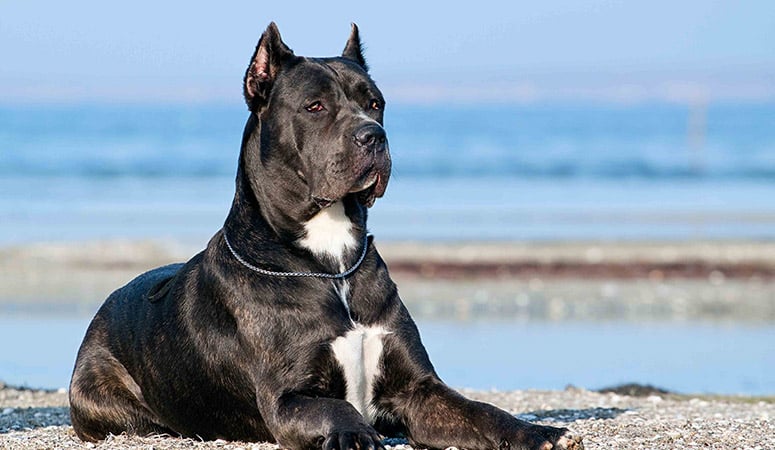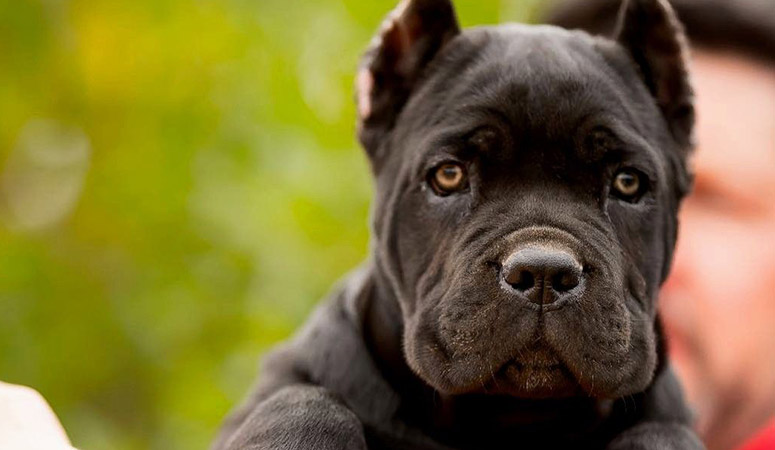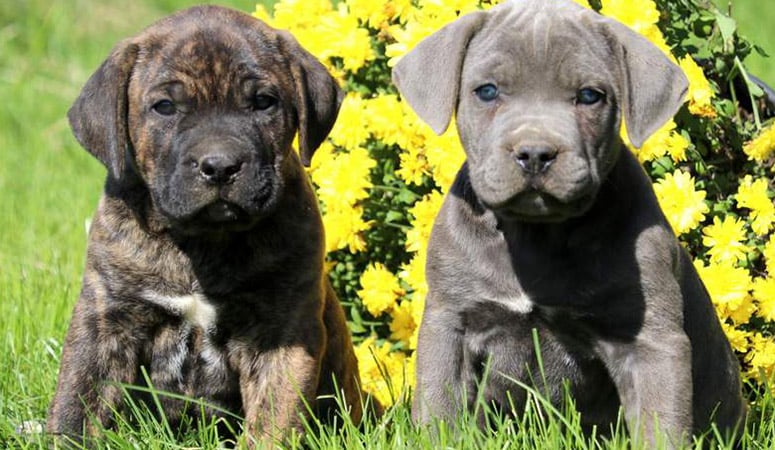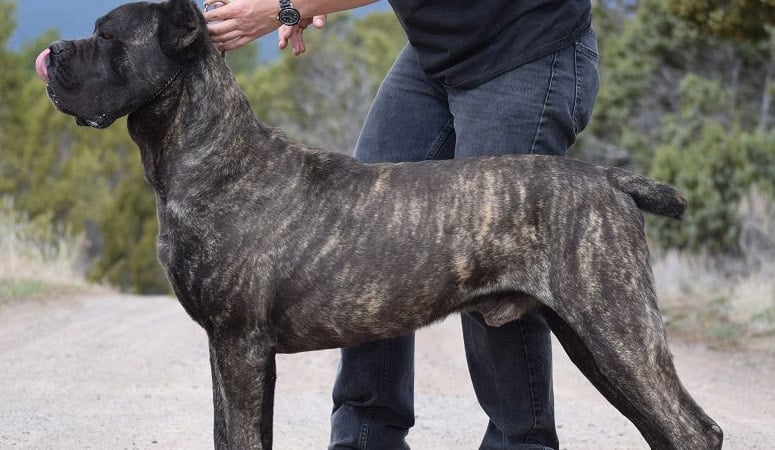Cane Corso
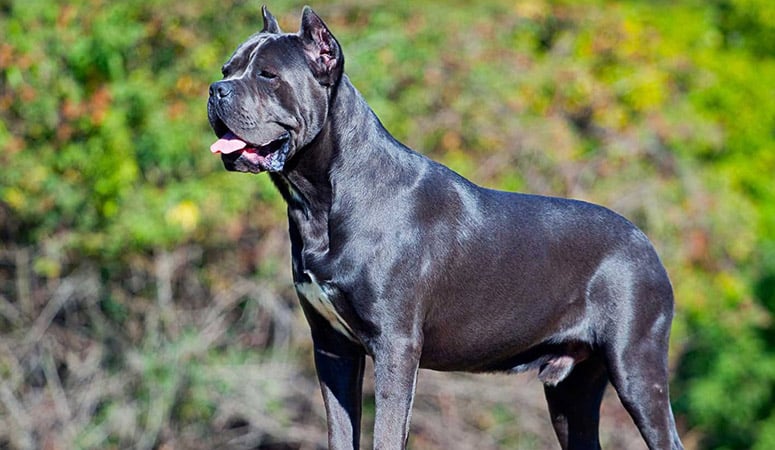
Smart, trainable, the Cane Corso is an Italian breed with a lengthy history. Medium to large size, sturdy, muscular, and athletic, this dog breed was developed to guard property and hunt big game such as wild boar. They never take time off from what they see as their most important duty which is to protect the home and their people.
| Other Names | Cane Corso Italiano, Cane Corso Mastiff, Italian Corso, Italian Corso Dog, Italian Mastiff, Italian Molosso |
| Color | Black, Black Brindle, Chestnut Brindle, Fawn, Gray, Gray Brindle, Red |
| Height | Males: 24-28 inches. Females: 23-26 inches. |
| Weight | Males: 92-110 pounds. Females: 80-100 pounds. |
| Life Span | 9-12 years |
| Personality | Affectionate, Intelligent, Majestic |
| Exercise | Energetic |
| Origin |
| Popularity | #30 |
| Groom Needs | Occasional |
| Kids Friendly | Yes with supervision |
| Dog Friendly | Yes with supervision |
| Watch Dog | Yes |
| Family Dog | |
| Litter Size | 4-6 |
Cane Corso Pictures
Cane Corso Video
Introduction
Basically, they appear in a stiff coat of black and fawn. The coat tends to get thicker in cold weather. In stature, the Cane Corso is magnificent, with strong and powerful limbs that bulge with muscles. The Cane Corso is, hence, well-adapted for its role as a fearless guard dog.
Sturdy and brawny, they move with grace and ease. They have a weight that is proportionate to the stature of the specific dog, although average figures exist. A standard male Cane Corso weighs around 100-105 pounds, standing at a shoulder height of 25-26 inches. A similar female may weigh 85-95 pounds, and measure 23-25 inches in height.
These dogs became popular not long ago, and have risen quickly to the 32nd spot by the American Kennel Club. They are loyal and live true to an average life expectancy of 10-12 years.
Living with Cane Corso
The Cane Corso has a short, but double-layered coat, the undercoat of him is different from length depending on the climate the dog lives in. The dog shed year-around, especially heavy during shedding season in the spring. Weekly brushing with a medium-bristle brush, a rubber grooming mitt or tool, or a hound glove will remove the dead hair and help remove dirt and promotes new hair growth as well. And daily brushing is recommended during the shedding season. Bathe is required only occasionally as necessary.
Check your Cane Corso’s ears weekly for the signs of infection, irritation, or wax buildup. Brush the teeth at least once a week to prevent gum disease and keep fresh breathe. Trim the nails regularly, because the overly long nails could be painful to the dog and cause walking and running problems.
This high-energy working breed needs plenty of physical activity to stay in shape. A brisk walk or running at least a mile in the morning and again in the evening will keep the dog’s health and muscle tone. Also, Cane Corsos are great companions on long walks, hikes, or bicycle rides.
The owner could provide your dog a job for mental stimulation, such as herding livestock, learning tricks, practicing obedience skills, or being involved in a dog sport. They are happiest when given a job to do.
However, Cane Corsos puppies should not be given too much exercise because their joints and bones are still growing, it may cause a few problems later on in their lives when given too much pressure on them.
Generally, it is recommended to feed a Cane Corso with four to five cups of high-quality dry dog food every day, and this should be split between two or three meals to prevent bloat. More importantly, the food amount should depend on the dog’s weight, size, age, and activity level. There should be fresh and clean water at all times.
Some dogs are easy to get overweight, so you need to watch their calorie consumption and weight level all the time. Treats may be an important aid in training, but excessive intake can lead to obesity. Also, owners need to distinguish which human food is safe for dogs and which are not. If you have any problems with your dog’s weight or diet, just consult from your veterinarian.
Cane Corsos are prone to the following health conditions: heart disease, epilepsy, hip and elbow dysplasia, bloat, eye diseases, ear infections in uncropped ears, allergies, demodex mange, eyelid abnormalities…
Major concerns: CHD
Minor concerns: cardiac problems, elbow dysplasia
Occasionally seen: ectropion, entropion, gastric torsion
Suggested tests:
Cardiac Exam
Hip Evaluation
Elbow Evaluation
Total Annual Cost: $3239
Cost is estimated for the first year and may vary depending on many factors, such as dog food, health care, leash, collar, licensing, possible fencing, crates, training and obedience classes, dog-walking, grooming, treats, toys, flea, tick, and heart-worm meds, microchips, etc.
Intelligent and eager to please, Cane Corsos are generally easy to train. They could learn basic obedience with ease, but they may be stubborn or dominant when they get older. For such a breed as big and strong, early socialization and puppy training classes are a must for them. Early socialization is very important as Cani Corsi tend to be wary of strangers, their potential for aggression with people and other animals would still exist without early, continued socialization.
The Cane Corso has a desire to please and enjoys learning. They have a competitive advantage and do well in agility, advanced obedience, and skill training. They may also enjoy tracking and nose work activities or competition.
History
The Cane Corso has a long and interesting history. They are believed to have originated from the Molossus breed, a mastiff-type breed, in ancient Rome. The ancestry of the Cane Corso (also called the Italian Mastiffs) can be traced back to the Roman empire, around the 12th century. It is rumored that, in ancient times, the Greek tribe of Molossi were breeders of giant Mastiff-type, which served for guarding property and people. When the Romans invaded the islands, they took away some of these Molossian dogs to Rome, where they were bred with native Italian dogs. The Cane Corso resulted from this series of crosses, alongside the larger Neapolitan dog breed.
The name Corso was adopted from the Italian word ‘Cohor’ which meant guardian. Originally, the Cane Corso was the Roman war dogs in the old times. These earlier breeds were intrepid, much larger and more intimidating than the modern-day Cane Corso. Part of their job during wartime was to carry pails of flaming oil across enemy lines.
Times changed and the classic war period began to fade out. The Cane Corsi had to adapt to a life of calm. They soon appeared on the farms, driving or herding livestock, guarding farmers against notorious hogs, and even protecting farmholds. Cane Corso began their journey to popularity on these plains, before a terrible blow happened to their survival. The World Wars I and II nearly saw this breed of dogs to extinction. By the end of both wars, the population of Cane Corso had drastically reduced, almost non-existent even.
Throughout the 20th century, they weren’t popular in homes as they used to be. It wasn’t until the 1970s brought breed enthusiasts who set out to resuscitate the dying Cane Corso breed that the breed sprung back into activity. The attempt was successful, and by the 1980s, this breed had found its way to countries in Europe and even America. About a decade later, they debuted in the show ring.
The Italian Kennel Club recognized this breed in 1994, while the American Kennel Club did the same in 2010.
Helpful Information
Breed Club: CANE CORSO ASSOCIATION OF AMERICA
Breed Club Link: http://www.canecorso.org/
Breed Club Rescue: CANE CORSO RESCUE
Breed Club Rescue Link: https://www.canecorso.org/rescue.html

